-
For more information on how to avoid pop-up ads and still support SkiTalk click HERE.
You are using an out of date browser. It may not display this or other websites correctly.
You should upgrade or use an alternative browser.
You should upgrade or use an alternative browser.
PSIA Centerline 1988
- Thread starter Steve
- Start date
- Joined
- Nov 12, 2015
- Posts
- 6,357
I just watched that too. My first thought was that I can't believe we still have people that don't know a wedge christie from a stem christie! That video clearly shows a wedge christie that would be current today and the video is 32 years old!
- Joined
- Nov 13, 2015
- Posts
- 2,338
Yes Erik, I would be very happy with students today being able to ski this progression. OK, maybe don't visibly lift the ski off the snow as much (except in drills), but all the elements of good skiing are there, albeit no discussion of separation which they clearly demonstrate.
Diverging parallel at the end to my eye introduces flex- to- release as well. Would you agree?
Diverging parallel at the end to my eye introduces flex- to- release as well. Would you agree?
Here are some of the graphics illustrating PSIA's Center Line teaching philosophy from Bob Barnes' Complete Encyclopedia of Skiing.




In that video, the wedge turns are done with quite a wide stance. This is not the "gliding wedge" stance width of today's lesson, which is supposed to use the same stance width as parallel turns. So this is a difference.
These guys sink and rise. PSIA has moved to rotating the relatively flat skis that the narrow stance creates instead of going up-down to get off and on that edged outside ski.
I think I like this old way better.

These guys sink and rise. PSIA has moved to rotating the relatively flat skis that the narrow stance creates instead of going up-down to get off and on that edged outside ski.
I think I like this old way better.
In the wedge christies, the skier's stance width increases as the skis enter the turn in a wide wedge, then the width narrows as the inside ski is brought into parallel. This too is a no-no these days, as the stance width is supposed to stay the same. Skiers are supposed to only rotate the skis at the ankle, not push the outside foot outward nor bring the inside foot inward. So this too is a difference.
The video has the skier rise at the start of the turn, and sink at the end, as in wedge turns.
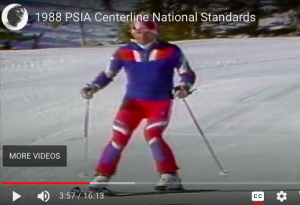
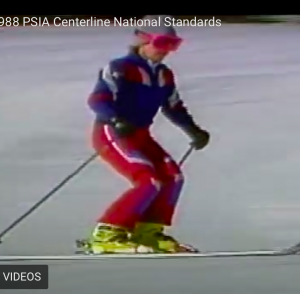
The video has the skier rise at the start of the turn, and sink at the end, as in wedge turns.


The Wedge Christie #2 has a narrower wedge, matching above the fall line, more speed, and is done on steeper terrain. The outside ski's edge turns the skier. We now have skiers use the narrow gliding wedge on flat beginner terrain, which produces less edge, and we ask them to rotate the skis at the ankle to get the skis to point down the hill. This is different from the video.
Do people here think this difference is significant?
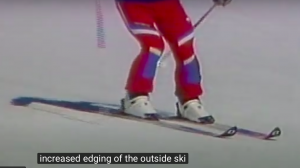
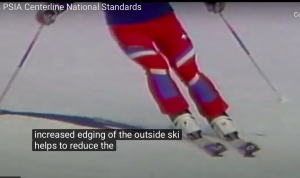
In this demo of Wedge Christie #2, this skier is pushing
the outside foot out to an edge, and her wedge is wide.
So maybe this was permitted because of the desire to
make room for variety in skier interpretation of what they
were supposed to do.
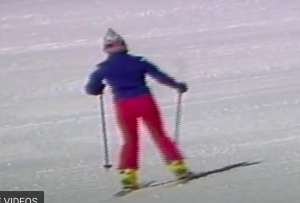
Do people here think this difference is significant?


In this demo of Wedge Christie #2, this skier is pushing
the outside foot out to an edge, and her wedge is wide.
So maybe this was permitted because of the desire to
make room for variety in skier interpretation of what they
were supposed to do.

Last edited:
Nice, thanks for posting this. As someone who learned on "straight" skis just before the shaped ski revolution, this brings back some fond memories.
Here are some words for Open Parallel turns.
All of this sounds very familiar. Skier is still getting tall
between turns.




And here's the small/tall.
Small at end of turn.

Tall at beginning of turn. This is not flex-to-release. It's extend-to-release.

Pushing the outside ski out to an edge, as in the wedge christie, is now gone. This turn happens when the skis get onto their new edges.

All of this sounds very familiar. Skier is still getting tall
between turns.




And here's the small/tall.
Small at end of turn.
Tall at beginning of turn. This is not flex-to-release. It's extend-to-release.
Pushing the outside ski out to an edge, as in the wedge christie, is now gone. This turn happens when the skis get onto their new edges.
Last edited:
Do people here think this difference is significant?
I think the equipment change allows for more subtle movements.
I disagree, at least in the modern sense of flex to release, as illustrated by instructional materials that we've been discussing in recent threads. It's true that the skiers in this video end up strongly flexing the new inside leg. However, this is only following a strong upward extension move by that leg, to shift balance to the new outside ski. That move is necessary in the style of turn being demonstrated, because at the end of the old turn the skier creates a substantial divergence of the skis, and a huge inside tip lead. The feet are so far apart at that point that the skier has no choice but to make that big balance-shifting move. If the skier were to skip that move, and proceed directly to flexing the new inside leg, the turn would have to start on the new inside ski. The new outside ski would be way out there somewhere, and the turn would have to develop a while before the consequences of centripetal force would shift balance over the new outside ski.The diverging parallels at 13:20 and on seem like flex to release to me.
The "diverging parallel turn" as demonstrated seems by today's standards a very odd technique to put into the centerline model.
Nice analysis!These guys sink and rise. PSIA has moved to rotating the relatively flat skis that the narrow stance creates instead of going up-down to get off and on that edged outside ski.
I think I like this old way better.
I think that both ways are problematic. An emphasis on sinking and rising leads developing skiers to strong extension moves when they start doing parallel turns, and that promotes pivoting at initiation. An emphasis on rotating flat skis likewise leads to pivoting when students start doing parallel turns.
It's all relative. From what I can recall of the old stem christie progression, the old snow-plough was much wider at the boots and tails, and the skis were tipped to a much higher edge angle. I can see that with more shape (modern skis) you would need less tipping and therefore an even narrower wedge would work.In that video, the wedge turns are done with quite a wide stance. This is not the "gliding wedge" stance width of today's lesson, which is supposed to use the same stance width as parallel turns. So this is a difference.
These guys sink and rise. PSIA has moved to rotating the relatively flat skis that the narrow stance creates instead of going up-down to get off and on that edged outside ski.
I think I like this old way better.
View attachment 99681
Does anybody remember when the switch from snow-plough to gliding wedge officially occurred ? I don't 'cause I taught myself from an antique book.
It's easy to see from the video why arc-2-arc pure carving (thin railroad tracks, but railroad tracks that diverge approaching the apexes and converge after apex) is rare and was even more rare back in the day, even the word carve is used to describe turns that are not what I would have called carved (and now call arc-2-arc pure carved to avoid confusion).
Nice analysis!
I think that both ways are problematic. An emphasis on sinking and rising leads developing skiers to strong extension moves when they start doing parallel turns, and that promotes pivoting at initiation. An emphasis on rotating flat skis likewise leads to pivoting when students start doing parallel turns.
Agree. There are problems with both approaches to teaching the wedge turn.
PSIA needs to stop insisting that the wedge turn can be taught with expert movements that don't need to be unlearned. That doesn't turn out to be true in the real world where skiers learn to turn in a wedge in a 1.5 hour lesson and then go up the hill with their friends for the rest of the day. Bad habits get deeply engrained fast when the skier is over-terrained.
The problems arising from starting people in a wedge could be avoided if only skiers would spend more time in lessons before the usual problems get embedded.
Mountains need to charge people less for lessons so they will take them more frequently, pay instructors more so ski schools won't be understaffed, and market lessons to adults more effectively so the quantity of lessons increases to fill the resulting revenue gap. In what world will that happen, ever?
Last edited:
It's always great to watch @EllenPost ski...it doen't take the whole screen. 
Let me see if I can get her to check in here.

Let me see if I can get her to check in here.
What happened to pandora timeline? I thought it was this summer too. Latest article I could find: https://www.aspentimes.com/news/loc...nsion-needed-to-keep-aspen-mountain-relevant/
Agree. There are problems with both approaches to teaching the wedge turn.
PSIA needs to stop insisting that the wedge turn can be taught with expert movements that don't need to be unlearned. That doesn't turn out to be true in the real world where skiers learn to turn in a wedge in a 1.5 hour lesson and then go up the hill with their friends for the rest of the day. Bad habits get deeply engrained fast when the skier is over-terrained.
The problems arising from starting people in a wedge could be avoided if only skiers would spend more time in lessons before the usual problems get embedded.
Mountains need to charge people less for lessons so they will take them more frequently, pay instructors more so ski schools won't be understaffed, and market lessons to adults more effectively so the quantity of lessons increases to fill the resulting revenue gap. In what world will that happen, ever?
A 1.5 hour lesson is ridiculous. The problem is not that PSIA is insisting that the wedge be taught but the mountains offering 1.5 hour lessons. I have taught at 2 western mountains. They offer 5 hour lessons. I have taught 2.5 hour lessons for latecomers in which I have to move through things faster. Those lessons sometimes work because there is usually only one or two people. PSIA does not dictate to the resorts the length of the lessons.
Teach people movement patterns that they can put together in a wedge or parallel turn and they can be off to the races. Teach leg rotation, edge release and flexion/extension movements and it is amazing what can happen.
- Joined
- Nov 13, 2015
- Posts
- 2,338
Private lessons are 1 hour where I teach and at most resorts I know of in the East. People can't afford to pay hundreds of dollars for a lesson.
Yes it is the resort, not PSIA. But that doesn't take the blame off of them. They do nothing to advocate for Instructor pay or to advocate for lower lesson costs. They are practically an arm of Ski Area Management. They specifically state that it is not their purpose to advocate for us or for the students. Their purpose is solely Educational and Certification.
There is no organization advocating for teachers or students.
Yes it is the resort, not PSIA. But that doesn't take the blame off of them. They do nothing to advocate for Instructor pay or to advocate for lower lesson costs. They are practically an arm of Ski Area Management. They specifically state that it is not their purpose to advocate for us or for the students. Their purpose is solely Educational and Certification.
There is no organization advocating for teachers or students.
Sponsor
Staff online
-
jimmyMixmaster
-
Jim KenneyTravel Correspondent
Members online
- Nathanvg
- JESinstr
- jimmy
- SKI-3PO
- Wade
- Yepow
- AngryAnalyst
- BullMcCabe
- motogreg
- DanoT
- ilovepugs
- Living Proof
- Jim Kenney
- smv
- Nancy Hummel
- wiread
- nemesis256
- aveski
- Marker
- Awalkspoiled
- truk8
- AaronCalay
- gwasson
- Miker
- eric100
- bbinder
- MissySki
- puptwin
- Snookit
- waxloaf
- David Orr
- François Pugh
- Gina D
- Hot.Tamale
- xiskiguy
- Phelmut
- graham418
- Spoorosew
- JPL
- butleri
- wnyskier
- Don4Fun
- easterner
- johnnyvw
- Peppermint
- Zrxman01
- Scruffy
- Stev
- Johnny V.
- surfski
Total: 3,220 (members: 80, guests: 2,190,robots: 950)



